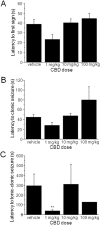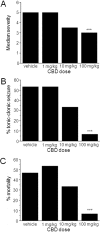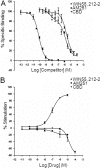Cannabidiol displays antiepileptiform and antiseizure properties in vitro and in vivo
- PMID: 19906779
- PMCID: PMC2819831
- DOI: 10.1124/jpet.109.159145
Cannabidiol displays antiepileptiform and antiseizure properties in vitro and in vivo
Abstract
Plant-derived cannabinoids (phytocannabinoids) are compounds with emerging therapeutic potential. Early studies suggested that cannabidiol (CBD) has anticonvulsant properties in animal models and reduced seizure frequency in limited human trials. Here, we examine the antiepileptiform and antiseizure potential of CBD using in vitro electrophysiology and an in vivo animal seizure model, respectively. CBD (0.01-100 muM) effects were assessed in vitro using the Mg(2+)-free and 4-aminopyridine (4-AP) models of epileptiform activity in hippocampal brain slices via multielectrode array recordings. In the Mg(2+)-free model, CBD decreased epileptiform local field potential (LFP) burst amplitude [in CA1 and dentate gyrus (DG) regions] and burst duration (in all regions) and increased burst frequency (in all regions). In the 4-AP model, CBD decreased LFP burst amplitude (in CA1 only at 100 muM CBD), burst duration (in CA3 and DG), and burst frequency (in all regions). CBD (1, 10, and 100 mg/kg) effects were also examined in vivo using the pentylenetetrazole model of generalized seizures. CBD (100 mg/kg) exerted clear anticonvulsant effects with significant decreases in incidence of severe seizures and mortality compared with vehicle-treated animals. Finally, CBD acted with only low affinity at cannabinoid CB(1) receptors and displayed no agonist activity in [(35)S]guanosine 5'-O-(3-thio)triphosphate assays in cortical membranes. These findings suggest that CBD acts, potentially in a CB(1) receptor-independent manner, to inhibit epileptiform activity in vitro and seizure severity in vivo. Thus, we demonstrate the potential of CBD as a novel antiepileptic drug in the unmet clinical need associated with generalized seizures.
Figures







References
-
- Abramoff MD, Magelhaes PJ, Ram SJ. (2004) Image processing with ImageJ. J Biophoton Int 11:36–42
-
- Ahrens J, Demir R, Leuwer M, de la Roche J, Krampfl K, Foadi N, Karst M, Haeseler G. (2009) The nonpsychotropic cannabinoid cannabidiol modulates and directly activates α1 and α1β glycine receptor function. Pharmacology 83:217–222 - PubMed
-
- Ben-Ari Y, Cossart R. (2000) Kainate, a double agent that generates seizures: two decades of progress. Trends Neurosci 23:580–587 - PubMed
-
- Bhattacharyya S, Fusar-Poli P, Borgwardt S, Martin-Santos R, Nosarti C, O'Carroll C, Allen P, Seal ML, Fletcher PC, Crippa JA, et al. (2009) Modulation of mediotemporal and ventrostriatal function in humans by Δ9-tetrahydrocannabinol: a neural basis for the effects of Cannabis sativa on learning and psychosis. Arch Gen Psychiatry 66:442–451 - PubMed
-
- Bisogno T, Hanus L, De Petrocellis L, Tchilibon S, Ponde DE, Brandi I, Moriello AS, Davis JB, Mechoulam R, Di Marzo V. (2001) Molecular targets for cannabidiol and its synthetic analogues: effect on vanilloid VR1 receptors and on the cellular uptake and enzymatic hydrolysis of anandamide. Br J Pharmacol 134:845–852 - PMC - PubMed
Publication types
MeSH terms
Substances
Grants and funding
LinkOut - more resources
Full Text Sources
Other Literature Sources
Medical
Molecular Biology Databases
Miscellaneous

